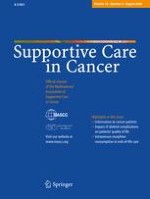Published in:

01-08-2008 | Original Article
Exploring the differential experience of breast cancer treatment-related symptoms: a cluster analytic approach
Authors:
Clement K. Gwede, Brent J. Small, Pamela N. Munster, Michael A. Andrykowski, Paul B. Jacobsen
Published in:
Supportive Care in Cancer
|
Issue 8/2008
Login to get access
Abstract
Introduction
Cancer patients experience multiple concurrent symptoms. This exploratory analysis assessed symptom burden among patients undergoing chemotherapy for breast cancer to identify distinct subgroups of patients who experience differential symptom burden and assessed whether the patient subgroups were associated with deleterious quality of life (QOL) outcomes.
Materials and methods
Women (N = 133) with stage I and II breast cancer undergoing adjuvant chemotherapy after primary surgery were evaluated at baseline and at the end of chemotherapy using the Memorial Symptom Assessment Scale (MSAS) and the SF-36 QOL questionnaire. Post treatment MSAS symptoms were included in hierarchical cluster analysis. Two patient subgroups were identified that corresponded to a high-symptom prevalence group and a low-symptom group.
Results and discussion
No marked, statistically significant differences were found between groups on demographic, symptoms, QOL, or treatment variables at baseline. Patients in the high-symptom cluster were more likely to have stage I disease (p < 0.05). The two groups of patients showed significant differences in end-of-treatment symptoms and QOL scores (p < 0.05). The high-symptom burden group was more likely to report greater symptom prevalence and poorer QOL.
Conclusions
Future research needs to examine why these differences occur despite similarities in treatment and how symptom burden can be reduced for the high-symptom prevalence group.